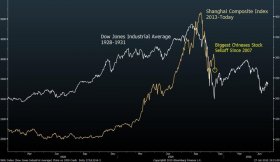
World Crisis
The Chinese stock crisis is the " new 1929 " , followed by an exhibit of the experienced American trader Tom De Mark. According to his prediction, a bubble bursting into the Shanghai Exchange will recall the fall of the Dow Jones index 84 years ago. As a result, the Chinese market has to fall by 14 per cent, concluding De Mark, which, among other things, successfully predicted the turning points of the Shanghai Composite in 2012-2013.

American Dow Jones Industrial Average (white curve) 1929-1931 and Chinese Shanghai Composite from 2013 to present (wheel curve)
Bloomberg
Maybe the crisis in Podnesbes will look like a canon. Great depression. Not only in shape, but also in content, from local disturbances to the global crisis. Since the Shanghai Index ' s rapid upsurge in mid-June, two " thought schools " for China have emerged, the 28 July review of Neil McKinnon, the macroeconomic strategy analyst on the global markets of ITC Capital.
First School Considers that the impact of the exchange bubble on the real economy of the Sub-Earth (and thus on the economy of the rest of the world) will be limited. Their arguments are:
- Shanghai Composite remains 13 per cent higher than at the end of last year, although almost 30 per cent lower than the maximum achieved on 12 June.
- The equity market plays a modest role in financing companies.
- Only 20 per cent of Chinese households are stocked against 65 per cent in the United States.
- The country ' s authorities have sufficient fiscal and monetary space.
- The banking sector in the CPD belongs to the State.
Secondary Considers that the Chinese stock market is a symptom of a wider phenomenon. Why?








